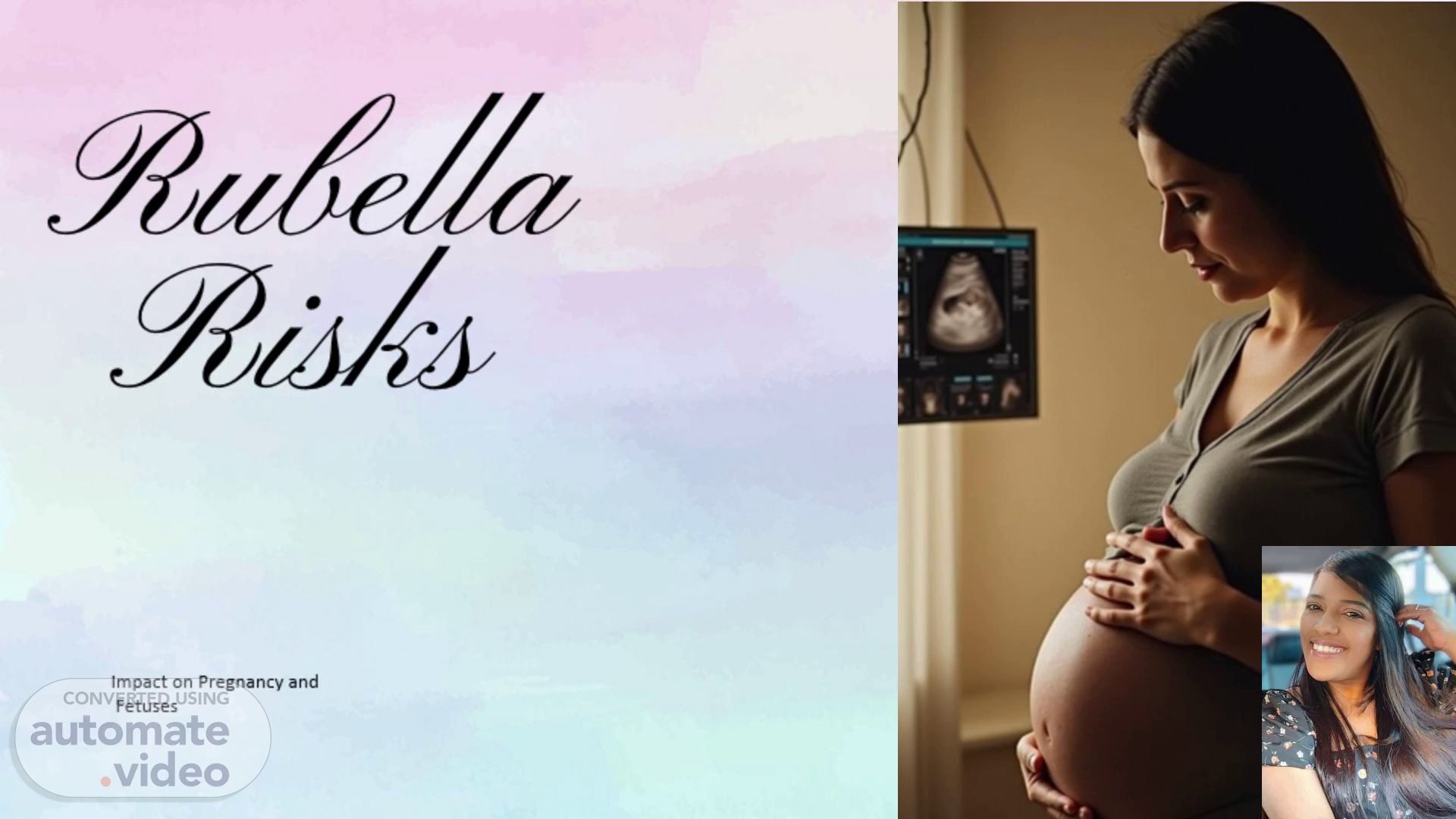Scene 1 (0s)
[image]. Impact on Pregnancy and Fetuses. Rubella Risks.
Scene 2 (7s)
Introduction. Rubella, a contagious viral infection also known as German measles, poses serious risks during pregnancy, particularly in the first trimester. It can lead to congenital rubella syndrome, causing severe fetal abnormalities. Understanding the viruss effects and the role of midwifery in prevention is crucial for maternal and neonatal health..
Scene 3 (25s)
[image]. Rubella and Pregnancy Risks.
Scene 4 (31s)
Rubella Virus Transmission and Impact. Rubella spreads through respiratory droplets and easily crosses the placenta to infect the fetus. Infection during early pregnancy is especially dangerous, often resulting in congenital rubella syndrome with critical defects in the heart, brain, and eyes. Its ability to disrupt fetal development highlights its silent but devastating nature during gestation..
Scene 5 (49s)
Maternal Symptoms and Diagnostic Challenges. Rubella infections in pregnant women often present mild symptoms like fever, rash, and swollen glands, making early diagnosis difficult. This subtlety can delay detection and increase fetal risk. Midwives play a key role in recognizing these signs and emphasizing antenatal screening to prevent congenital infections..
Scene 6 (1m 6s)
Effects on Fetal Development and Organs. The virus invades the placenta, directly impacting fetal tissues during the perinatal period. It disrupts cell division and blood vessel formation, causing cataracts, heart defects, hearing loss, and growth delays. Awareness of these effects is essential for early intervention and specialized care to minimize lifelong complications..
Scene 7 (1m 24s)
Antenatal Screening and Early Detection. Early detection through antenatal screening is vital for identifying rubella infections and preventing fetal transmission. Midwives are instrumental in conducting screenings, educating expectant mothers about risks, and initiating referrals. This proactive approach helps mitigate adverse outcomes by enabling timely medical interventions throughout pregnancy..
Scene 8 (1m 40s)
Immunization and Vaccination Promotion. The MMR vaccine is the most effective preventive measure against rubella. Midwives champion vaccination efforts among women of reproductive age, particularly before conception. Promoting immunization not only protects individual mothers and their babies but also reduces community transmission, safeguarding public and neonatal health on a broader scale..
Scene 9 (1m 57s)
Neonatal Care and Multidisciplinary Coordination.
Scene 10 (2m 12s)
[image] n Ill. Effects on Fetal Development and Organs.
Scene 11 (2m 33s)
Antenatal Screening and Early Detection. Antenatal screening is critical for identifying rubella infections early in pregnancy to prevent fetal transmission. Midwives are key in conducting these screenings, educating women on infection risks, and facilitating timely referrals. Effective early detection helps avert serious congenital conditions and supports healthier pregnancy outcomes..
Scene 12 (2m 49s)
[image]. Immunization and Vaccination Promotion. Vaccination with the MMR vaccine remains the most effective strategy for preventing rubella infection. Midwives play a pivotal role in promoting immunization, particularly for women of reproductive age prior to conception. This preventive approach safeguards both maternal and neonatal health while supporting community-wide disease control..
Scene 13 (3m 6s)
Neonatal Care and Multidisciplinary Coordination.
Scene 14 (3m 21s)
Conclusions. Midwives hold a crucial position in combating rubella through education, screening, vaccination promotion, and coordinated neonatal care. Their efforts directly impact the prevention of congenital rubella syndrome and improve outcomes for mothers and infants. Upholding these responsibilities ensures safer pregnancies and healthier generations, reflecting the cornerstone of quality midwifery practice..
Scene 15 (3m 39s)
Thanks!. Do you have any questions? [email protected] +34 654 321 432 yourwebsite.com.
